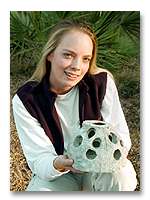 |
 | ||||
|
Web posted
Today, the river bottom consists merely of sand as far as the eye can
see -- which in the murky water isn't really all that far. Still, club
members say, the tides ripping in and out of the saltwater river tear
almost anything living on the bottom away, leaving a bare, boring,
lifeless aquascape.
They want to change all that.
At their monthly meeting last Thursday, club members agreed to try to
raise enough money to buy 50 massive concrete "reef balls" to create an
artificial reef -- or even a series of small reefs -- along the winding
river's course.
Reef balls are large pyramids of porous concrete that allow footholds
for all types of aquatic life, from fish to algae. A 3-foot-by-4-foot ball
costs $200. So far, the 15-member club has bought five.
The club's reasons for wanting the reef balls in the river are
three-fold, member Justin Kelley said.
First, the divers want something beside the occasional crab or skate to
watch and they figure the reef balls will give them just that.
Second, it never hurts to help animals establish a foothold in an
otherwise barren, tide-swept river, he said. Informational videos club
members have watched show the balls are usually covered by algae and coral
just a year after entering the water.
Third, the balls could act as repositories for fossils the tides might
otherwise expose and carry away. Club divers often explore the river
bottom searching for all types of ancient remains, from mastodon teeth to
whale vertebrae. But the tide, Kelley says, takes its share, too.
Club president Amber Hester said the club hopes to establish a series
of small reefs in the river, all sunk deeply to keep them out of the reach
of whatever boats ply the water.
The reefs will be carefully marked by buoys, she said. Club members
have agreed to monitor the reefs at least once each month, taking videos
and tracking their progress.
"Coral is slow growing," she said. "It's not going to be like 'Shazaam!
Growth!' "
The state Department of Natural Resources has regulatory power over
what goes in its rivers, so Hester will still have to ask permission
before the reef balls can enter the May. She expects the DNR will agree,
but she has a backup plan just in case.
The DNR has approved reef balls for use in the ocean, including off
Tybee Island in Georgia. It has also approved the use of old military
equipment off Hunting Island. Hester believes the state will have no
problem with making a small reef off Hilton Head, perhaps only a few miles
out. But the May is unquestionably her first choice.
The nearest natural reef is Grays Reef, 26 miles offshore and
completely out of the reach of small boats like Hester's.
"I definitely want one to be accessible to my boat so it can be
checked," she said. "I want to make a research study out of it."
The Bluffton native has a bachelor's degree in biology from the
University of Georgia; she has applied for graduate school at Nova
Southeastern University at Fort Lauderdale, Fla. She hopes to get a
master's degree in marine biology.
Anyone can sponsor a reef ball, Hester said, simply by contacting the
dive club. The reef balls can be personalized with the donor's name or a
special message. Even the buoys marking the reefs can carry a message or
monogram.
The reef balls, though made of concrete, are specially designed to be
completely non-toxic, Hester said. They will be only good for an
environment heavy fishing has seriously harmed, she said.
"(Reef balls) could increase the fish population," she said. "There
will be more food for them. There's more places for them to hide, to
escape from predators."
Anyone wishing to donate to the club's reef ball project can call
Island Scuba Dive & Travel at 689-3244 or Hester at 298-0133.
Donations of any amount will be accepted, Hester said.
The dive club meets the second Tuesday of each month at 7 p.m. at
Island Scuba Dive, located just off Mathews Drive. The public is invited.
What is a reef ball?
Reef balls, a term trademarked by the Woodstock, Ga.-based Reef Ball
Foundation, are massive concrete structures specially designed to support
underwater life.
The balls, according to the foundation's Internet site -- http://www.reefball.org/ -- are made
by pouring virtually any type of concrete into a fiberglass mold. The
concrete used must contain various additives to make it non-toxic for
aquatic life. The concrete itself is porous, providing firm footholds for
algae and other tiny life forms.
The mold contains a specially made "bladder" that is connected to
various sized inflatable balls. Concrete is then added to the mold. After
the concrete hardens, the bladder and air-filled balls are removed,
leaving a reef ball filled with holes that offer fish a place to hide from
predators.
The structures usually resemble pyramids more than balls, with a heavy
square base used to anchor them to the bottom. Within a year, the ball is
usually covered with underwater life.
A 3-foot-by-4-foot ball costs about $200.
Reporter Rob Dewig can be reached at 837-5255, ext. 107.
Search our news
archive
Site
questions or comments to Webmaster@lowcountrynow.com. | ||||||||||||||||||||||||
